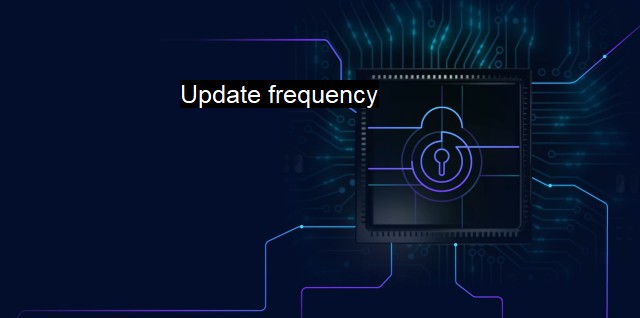What is Update frequency?
Understanding the Importance of Update Frequency in Cybersecurity and Antivirus Software
Update Frequency, especially in the context of cybersecurity and antivirus software, is an essential element to be comprehended for robust and seamless digital operations. It essentially refers to the routine or regularity with which software updates or new versions are released by cybersecurity firms or antivirus vendors.In detail, the concept of Update Frequency reflects the responsiveness of cybersecurity firms to ever-increasing and evolving cyber threats. A high Update Frequency helps the software miss fewer new threats. On the other hand, a low Update Frequency signifies that the software may not be as contemporary or updated as it should ideally be, which can pose a severe potential risk.
It is important to note that these updates are fundamental to tackling almost all types of computer security threats. These updates can range from bug fixes, patches to the operating system, feature enhancements, updates to the antivirus software signatures, detection logic, adding new threat intelligence, to even sometimes responding to a complex, high-risk security threat such as zero-days.
Virus definitions or signatures play a crucial role in antivirus software. They are the key knowledge source the software refers to, for the identification and tackling of viruses. More updated the definitions, higher the probability of detecting and eliminating a wider spectrum of malware or threats.
The IT realm has an ultra-dynamically evolving threat landscape. Every day, thousands of new malware are being created. Legacy signature-based antivirus was designed in an era when hundreds of malware were being created daily. Therefore, they can fall short with the volume, variety, and blended threats today. Crowdsourced and cloud-based threat intelligence, and technologies like machine learning and artificial intelligence (AI), are now being used to manage the overwhelming proliferation of malware and advanced threats. The higher the frequency of updates to the virus definitions and signatures, the more protected the user's systems.
The frequency of these updates varies from one cybersecurity firm or antivirus vendor to another. Some provide real-time updates, daily updates, or even an on-demand update service. Typically, antivirus software performs automatic updates periodically. Due to ever-increasing cyber threats, sometimes even several updates may be rolled out in a day. Advanced options nowadays even provide cloud-enhanced updates.
Increasing update frequency can be a double-edged sword. Increased frequency often results in a large volume of updates that need to be processed and consumed at the user's end. This could lead to inconveniences for the end-users, including significant network bandwidth consumption, system slowdown, or even sometimes a system reboot is required to fully implement these updates. Striking an efficacious equilibrium between maintaining a satisfactory update frequency while still limiting potential user inconveniences is the challenge for cybersecurity firms.
Understanding update frequency and its implications on cybersecurity becomes utmost necessary in today's digitally driven era. These updates are the first line of defense against newly arising threats that antivirus and cybersecurity software provide. They ensure that the user's data and digital assets stay secure against growing and continuous cyber threats. Equally importantly, they minimize the gaping holes in the system, rendering them unable to be exploited by cybercriminals.
Update frequency is a substantive parameter in the determination of the regime and level of protection that a cybersecurity solution renders. While the frequency may vary among products, their sustaining prescience in the lineup of cybersecurity methodologies signifies their empowered position as formidable defense mechanisms against the continuously evolving cyber threats. Therefore, being conscientious about your cybersecurity firm or antivirus vendor's update frequency can be momentous in swaying the balance towards a high level of digital security.

Update frequency FAQs
How often do antivirus programs release updates?
Antivirus programs release updates regularly, typically several times a day. This is because new threats are constantly emerging, and updates contain the latest definitions and signatures to protect against them.What happens if I don't update my antivirus software?
If you don't update your antivirus software, it will become outdated and less effective at protecting your device from new and evolving threats. This leaves your device vulnerable to potential attacks, which can result in serious consequences such as data breaches, identity theft, and other cybersecurity risks.Can I set my antivirus to update automatically?
Yes, most antivirus programs have an option to enable automatic updates. This ensures that your software is always up to date with the latest definitions and signatures without you having to manually initiate the update process.What should I do if my antivirus program fails to update?
If your antivirus program fails to update, you should first check your internet connection to make sure it is stable and strong. If the problem persists, you may need to uninstall and reinstall the software or contact the antivirus provider's customer support for further assistance. It's essential to address any issues with updating your antivirus program promptly to ensure your device's continued protection against cyber threats.| | A | | | B | | | C | | | D | | | E | | | F | | | G | | | H | | | I | | | J | | | K | | | L | | | M | |
| | N | | | O | | | P | | | Q | | | R | | | S | | | T | | | U | | | V | | | W | | | X | | | Y | | | Z | |
| | 1 | | | 2 | | | 3 | | | 4 | | | 7 | | | 8 | | |||||||